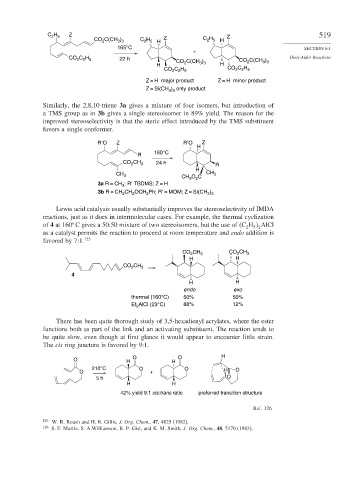Page 545 - Advanced Organic Chemistry Part B - Reactions & Synthesis
P. 545
H
C 2 5 Z Z 519
CO C(CH ) C H Z C H
2 5 H
2 5 H
3 3
2
165°C SECTION 6.1
+
CO C H 22 h CO C(CH ) CO C(CH ) Diels-Alder Reactions
2 2 5
H 2 3 3 H 2 3 3
CO C H CO C H
2 2 5
2 2 5
Z = H major product Z = H minor product
Z = Si(CH ) only product
3 3
Similarly, the 2,8,10-triene 3a gives a mixture of four isomers, but introduction of
a TMS group as in 3b gives a single stereoisomer in 89% yield. The reason for the
improved stereoselectivity is that the steric effect introduced by the TMS substituent
favors a single conformer.
R′O Z R′O Z
H
180°C
R
CO CH 3 24 h R
2
H
CH
CH 3 3
CH 3 O C
2
3a R = CH ; R′ TBDMS; Z = H
3
3b R = CH CH OCH Ph; R′ = MOM; Z = Si(CH )
3 3
2
2
2
Lewis acid catalysis usually substantially improves the stereoselectivity of IMDA
reactions, just as it does in intermolecular cases. For example, the thermal cyclization
of 4 at 160 C gives a 50:50 mixture of two stereoisomers, but the use of C H AlCl
2 5 2
as a catalyst permits the reaction to proceed at room temperature and endo addition is
favored by 7:1. 125
CO CH 3 CO CH 3
2
2
H H
CH
CO 2 3
4
H H
endo exo
thermal (160°C) 50% 50%
AlCl (23°C) 88% 12%
Et 2
There has been quite thorough study of 3,5-hexadienyl acrylates, where the ester
functions both as part of the link and an activating substituent. The reaction tends to
be quite slow, even though at first glance it would appear to encounter little strain.
The cis ring juncture is favored by 9:1.
O O H
O H H
210°C O O O
O + H
5 h O
H H
42% yield 9:1 cis:trans ratio preferred transition structure
Ref. 126
125 W. R. Roush and H. R. Gillis, J. Org. Chem., 47, 4825 (1982).
126
S. F. Martin, S. A.Williamson, R. P. Gist, and K. M. Smith, J. Org. Chem., 48, 5170 (1983).

